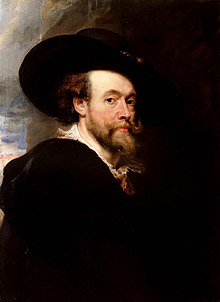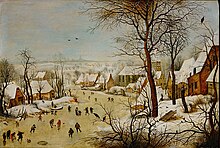Art of Belgium
| Part of a series on the |
| Culture of Belgium |
|---|
 |
| History |
|
People |
| Languages |
|
Mythology and Folklore |
|
Cuisine |
| Religion |
| Art |
| Music |
| Sport |
Despite its size, Belgium has a long and distinguished artistic tradition that goes back to the
Important monasteries in Belgium were centres of production in Carolingian art and Ottonian art, and later the area producing Romanesque Mosan art is now largely in Belgium. Flanders became one of the richest areas in Europe in the later Middle Ages and Early Netherlandish painting produced work for both the wealthy townspeople as well as the courtiers of the Duke of Burgundy.
In the Renaissance
History of Belgian art
| History of Dutch and Flemish painting |
|---|
| Periods |
|
| Lists |
Medieval art
Mosan art is a regional style of Romanesque art from the valleys of the Meuse in present-day Wallonia, and the Rhineland, with manuscript illumination, metalwork, and enamel work from the 11th, 12th and 13th centuries. Among them the masterpiece of Renier de Huy and perhaps of the whole Mosan art Baptismal font at St Bartholomew's Church, Liège. The architecture of Romanesque churches of the
Early Modern art

During the so-called Northern Renaissance, Belgium experienced an artistic boom, spawning the immensely popular Baroque Flemish school of painting. The cities of Bruges and Antwerp, some of the richest in the region, became artistic centres during the period.
The artist Peter Paul Rubens painted in Belgium between 1609-1621, working for many royal patrons from his studio in Antwerp. Rubens' house in Antwerp, the Rubenshuis, is now a museum.
Anthony van Dyck, celebrated for his painting of British court, including Charles I, was born in Antwerp.
The Brueghel Dynasty

- See also Bruegel Family
Flemish genre painting is strongly tied to the traditions of Pieter Bruegel the Elder and was a style that continued directly into the 17th century through copies and new compositions made by his sons Pieter Brueghel the Younger and Jan Brueghel the Elder. Many of these are kermis paintings and scenes of peasants partaking other outdoor enjoyments viewed from an elevated viewpoint.
Belgian art in the 19th-20th centuries
Neoclassicism
In the 18th century painting in the Southern Low Countries became increasingly focused on France. Many Flemish and Walloon painters studied in Paris and adopted the new neoclassical style en vogue in the last decades of the 18th century. The Bruges painter Joseph-Benoît Suvée made a career in the French capital where he was a rival of Jacques-Louis David. The latter settled in Brussels after the fall of Napoleon. Their major followers in Belgium (then part of the United Kingdom of the Netherlands) where Joseph Denis Odevaere and François-Joseph Navez.
Impressionism and neo-impressionism
Originating in France,
Belgian Surrealism
Surrealism developed in Belgium during the inter-war period. The best-known Belgian surrealist, René Magritte, exhibited in 1927 for the first time.
Sculpture

Jacques du Broeucq was a sculptor of the 16th century, known for his religious scenes and as the teacher of the famous Italian late-renaissance sculptor Giambologna, who was himself born in Flanders.
Constantin Meunier was an influential Belgian sculptor of the late 19th-early 20th century, known for his figures, which unusually, often depict industrial workers. Meunier's work was very popular around Europe, coinciding with the rise of the political Labour movement in the late 19th century.
Architecture

Belgian architects had been at the forefront of the Neoclassical architecture movement between the mid 18th and 20th centuries. The style enjoyed great popularity in Belgium and several neoclassical masterpieces, including Gembloux Abbey and the Château de Seneffe survive.
In the last quarter of the 19th century, the Belgian architect and furniture designer Gustave Serrurier-Bovy[1] is credited (along with Belgian architects Paul Hankar, Victor Horta and Henry van de Velde) with creating the Art Nouveau style, coined as a style in Paris by Bing.[2]
The Art Nouveau style enjoyed considerable popularity in Belgium until after the
Cartoons
A museum in Brussels, the Belgian Comic Strip Center, is devoted to Belgian cartoon art.
Modern art in Belgium
This section is empty. You can help by adding to it. (February 2013) |
Notable art collections in Belgium

The most significant art collection in the country is the national collection at the Royal Museums of Fine Arts of Belgium in Brussels, however, there are more than a dozen other significant art collections around the country.
Some of the most impressive are the
There are also numerous smaller museums, often supported by the state, focused on individual artists, with museums devoted Magritte, Wiertz and Meunier amongst many others.
Belgium also has numerous galleries devoted to collections of non-indigenous art, including Oriental,[5] Classical[6] and Congolese[7] painting, sculpture and other visual art.
See also
References
- ^ "Furniture by Gustave Serrurier-Bovy". Art Net. Retrieved 26 March 2013.
- ^ "Art Nouveau in Belgium (1880-1914)". Your Antique Furniture Guide. Retrieved 26 March 2013.
- ^ "Comic book capers". Expatica.com. 6 October 2008. Retrieved 26 March 2013.
- ^ Kennedy, Maev (19 November 2003). "Museum aims to draw crowds with cartoon boy wonder aged 75". The Guardian. UK. Retrieved 12 September 2006.
- ^ "Museums of the Far East, Laeken" (in French). Retrieved 10 November 2012.
- ^ "Ancient collection of the Musée du Cinquantenaire" (in French). Retrieved 10 November 2012.
- ^ Over 4,000 Congolese works of art in the Royal Museum for Central Africa alone, according to "Unique and priceless heritage An overview of our collections". africamuseum.be. Retrieved 10 November 2012.
Further reading
- "Art Museums in Belgium, artcylopedia.com". Retrieved 10 November 2012.
- Allmer, Patricia and Hilde van Gelder (eds) Collective Inventions: Surrealism in Belgium, Leuven: Leuven University Press, 2007.
- Allmer, Patricia and Hilde van Gelder (eds) "The Forgotten Surrealists: Belgian Surrealism Reviewed", Image [&] Narrative, issue. 13, 2005. [1]
